Why Townsville’s dedicated carers spend countless hours and dollars saving our wild animals
Some of Townsville’s most dedicated wildlife carers have explained why it is important to care for our most vulnerable of animals.

Townsville
Don't miss out on the headlines from Townsville. Followed categories will be added to My News.
Margaret Neihoff has her hands full.
She spends most of her waking hours, and a few hours at night, tending to her six “babies”.
But for the Kirwan retiree, it’s a labour of love that she says she will be doing until she no longer is able-bodied.
Mrs Neihoff, 79, has been caring for the region’s most vulnerable native animals for nearly 40 years. The retired public servant has been recognised for her tireless efforts recently, being named a finalist in the city’s Senior Awards.
Mrs Neihoff says she cares for the animals until they are stable enough to be handed to the next carer.
“I look after the real small macropods. They are not really cute and cuddly, they are more furless and fragile,” she says.
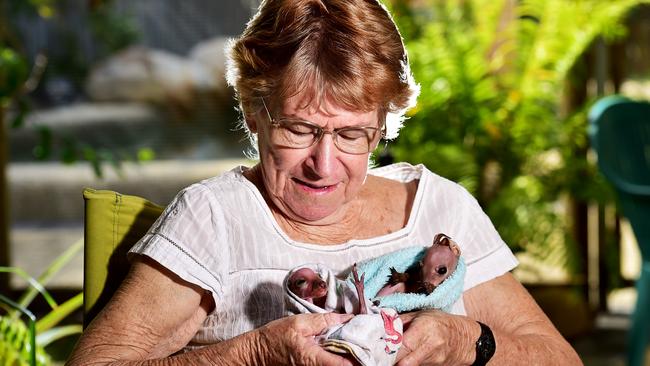
“I take them in at their most vulnerable, when they need the most care, when they are the most helpless. It is very rewarding to me to nurture the animals to strength.”
The dedicated native wildlife carer has a permit to care for 16 animals but says when the animals in her care number about 13 she struggles.
“I find there are not enough hours in the day and night to care for more than 13, 14 animals when they are so needy,” she says. “I have six at the moment. The smallest one came to me when it was only 112g.
“I have a limit on the size I accept. I typically only accept animals over 100g in weight. But I’m a softie and if an animal lands on my doorstep and they are just under 100g I can’t help take them in.
“If I don’t to it, who will? So I just do it. I want to give the animals the best chance of survival.”
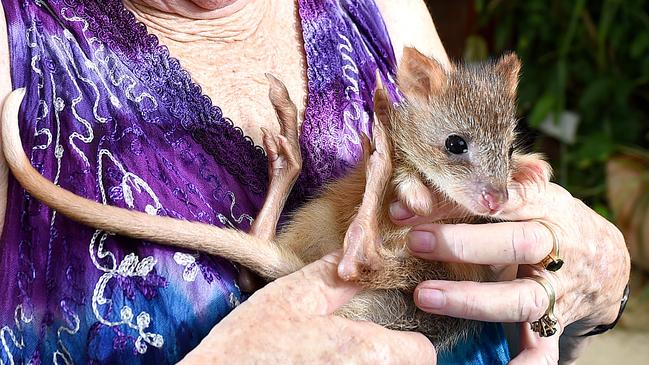
Mrs Neihoff is one of 200 members of the NQ Wildlife Care Inc, a voluntary non-profit organisation that helps native wildlife in North Queensland.
NQ Wildlife Care president Dominique Thiriet says that of the 200 members about a third are active volunteer carers.
“To be a carer takes a level of commitment, of course. Some carers are able to juggle their jobs with caring for animals while other carers are retired and spend a large part of their days, and a part of their nights, caring for animals,” Mrs Thiriet says. “Some animals need an incredible amount of time put to their care while other animals don’t need a high level of care.”
Mrs Thiriet says the volunteer wildlife carers are a “devoted and fantastic group of people”.
“All the volunteers have a united goal: to provide care for our sick or injured native wildlife until they are rehabilitated and can be released back into the wild,” she says.
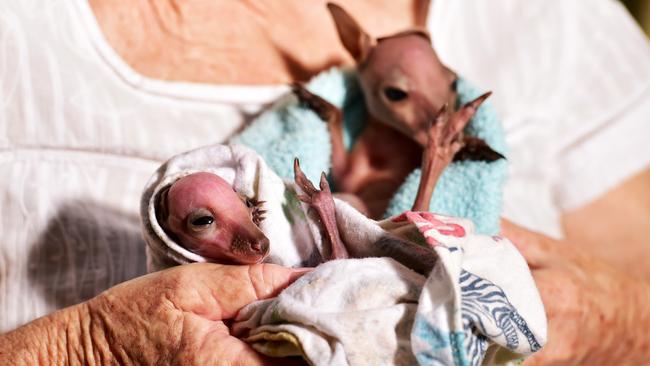
“It takes a special person to care for such animals, and I take my hat off to each and every one who volunteers to be a wildlife carer.”
It is estimated the group cares for almost 3000 native animals each year including bandicoots, kangaroos, koalas, possums, wallabies, birds, flying foxes, quolls and goannas.
Volunteers care for the animals in their own time, in their own homes and at their own expense.
“We hold regular training events for potential, new and experienced carers through the year,” she says.
“We aim to continuously develop carers’ skills and to raise public awareness of the wild animals found around us, their needs, the dangers they face and what can be done to protect them.”
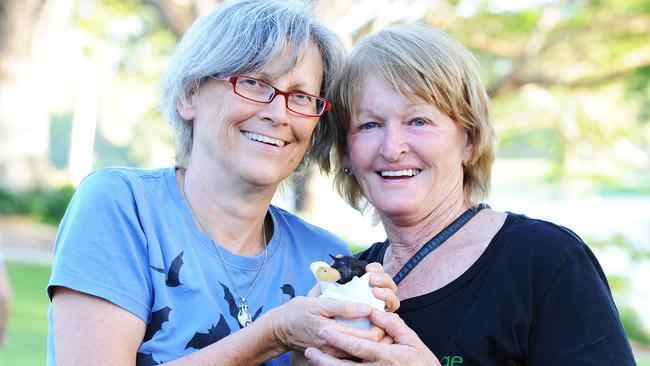
WHAT YOU CAN DO TO HELP WILDLIFE
• Don’t let your pets chase wildlife
• Keep dogs and cats inside from dusk to dawn
• Slow down at night when driving
• If you hit an animal when driving, stop and check if it’s injured and whether it has a joey in its pouch
• Use wildlife-friendly netting and fencing
• Be patient and tolerant when wildlife visits your garden
• If you want to feed wildlife, seek advice regarding suitable food
• Donate to the North Queensland Wildlife Care as the organisation doesn’t receive government funding.
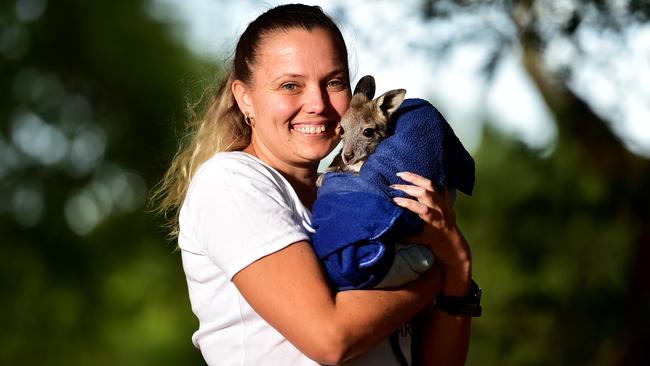
Rebecca Crook has been a wildlife carer for the past year but has already positioned herself as a valuable and treasured member of the volunteer team.
“In the past I was a foster carer to domestic animals but I have found caring for native animals even more rewarding,” the 33-year-old says.
“I have five animals in my care at the moment, two possums and three wallabies, so I’m pretty busy with it all.”
Ms Crook juggles being a wildlife carer with her full-time job in the child care industry. She jokes about the popular culture trope “never work with children or animals”.
“And I wouldn’t change a thing about either,” she says. “My day consists of waking up about 4am to do my first lot of feeds. Then I do the next lot of feeds at 8am. Then I go to work. During my lunch break I race home to do another feed. When I get home from work I do another lot of feeding and then before I go to bed.
“I am busy but it is so wonderful to see the animals gain strength.”

And Ms Crook doesn’t get too much of a break from animal caring on the weekend, as she happily volunteers to take a 24-hour rescue call shift.
“I do a lot of animal retrievals from animals rescued as a result of motor vehicle collisions, to rat trap incidents, to dog attacks,” she says. “It can be overwhelming at times, it can be emotionally and physically exhausting but I wouldn’t be volunteering so much of my free time to native animals if I was not 100 per cent passionate about their care.
“A carer needs to be loving but strong as you need to love the animals in your care but you have to be strong enough to say goodbye to them. Our goal is for the animals to be released back in the natural habitat. The animals are not our pets, they don’t belong to us. The animals belong in nature and that our job is to get them back to their home environment.”
Ms Crook, who has a permit to care for 10 native animals, says post flood was the busiest time for the organisation.
“A lot of our carers were in areas that were not accessible so the carers that were able to care for animals were inundated,” she says. “The time after the flood opened my eyes to how vulnerable our native wildlife is, and it has made what I do even more rewarding.”
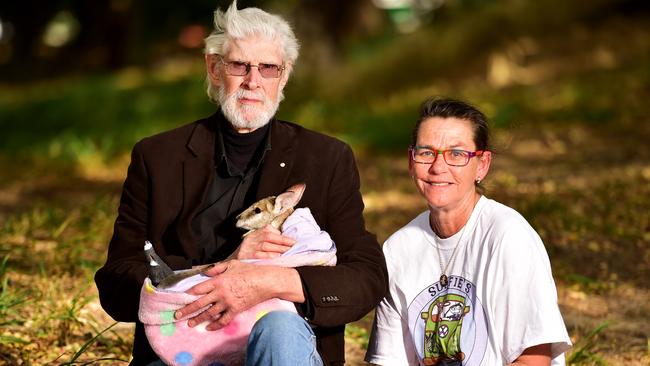
Cloncurry wildlife carer Maggie Hughes has been looking after the region’s native animals for close to 40 years.
She has received three Australia Day Awards for her work and dedication to injured wildlife.
Ms Hughes says that being a wildlife carer in remote areas such as Cloncurry means thousands of kilometres of travel to collect injured wildlife.
“Because of the regional and rural remote location I have … difficulty accessing services to do any kind of specialised treatments,” she says. “I also need the support of metropolitan vets and Palm Vets in Townsville have been amazing not only assisting with the ongoing treatments and also allowing Dr Howard Ralph to use their facilities.
“The average round trip just to rescue a joey out there is 250km but I have travelled up to 1200km in a round trip to rescue (an animal) — much higher fuel costs as opposed to metropolitan carers.”

WHAT TO DO IF YOU FIND A NATIVE ANIMAL IN TROUBLE
• If it is safe to do so place the animal in a suitably sized cardboard box with a towel at the bottom
• Keep the animal in a warm, dark, quiet place
• Do not give the animal food or drink
• Handle the animal as little as possible
• Call North Queenesland Wildlife Care on 0414 717 374 ASAP
TO FIND OUT more about HOW YOU CAN HELP NQ WILDLIFE CARE INC, GO to nqwildlife.org.au/
Originally published as Why Townsville’s dedicated carers spend countless hours and dollars saving our wild animals


